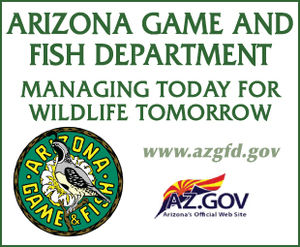Arizona Lakes, Arizona Pros - Rob Vanderkooi
It's A Great Time Of The Year For Carolina Rigs
October 1, 2018
I've known Rob Vanderkooi for decades and he's one of the best bass fishermen I know. He's also a heck of a good hunter. Rob guides for The Arizona Fishing Guides now, so if you want to learn some great techniques and have a super good time, call them and set up a day fishing with him.
Carolina Rigs Come To Mind
One thing I always think of when Vanderkooi comes to mind is Carolina Rigs. I'll never forget when he and his partner brought a 42-pound 6-fish limit to the scales in an All Star tournament years ago. They caught all those fish out of a single tree on Lake Pleasant. It blew everyone away! The big fish were all caught out of a single tree on a long point in the back of a large cove.
The time was late summer, and Rob says he thinks the fish liked that point because it gave them a huge variety of depths to move to as conditions changed: a steep area for quick escapes into deep water, and a lot of trees to choose from at different depths. The trick here was finding the right tree, which was a matter of figuring out what depth the fish were using, then fishing each tree at that depth until he hit the jackpot.
This Is Simple Fishing
Carolina rig fishing is simple. A large weight and a glass or plastic bead are strung onto the main line. The bead protects the knot from the heavy weight. A swivel is then tied to the end of the line, and a leader, usually of slightly lighter line, is attached to the swivel.
Tie on a hook and you're rigged, Carolina style. The weight can be a big bullet sinker or an egg sinker, and a harder metal makes a more high-pitched noise when it hits rocks.
Good Hooks For This Rig
Mustad, Gamakatsu, Berkley and a host of other manufacturers make good hooks for the Carolina rig. An extra-wide gap hook is best, and the hook has to be very sharp, fine, and strong. There is a lot of line between you and a fish when you set the hook, so the more easily the hook penetrates, the better.
Don't scrimp on your swivels, either. The last thing you want is to finally get a hog on, only to have your swivel break. Braid for the main line for great hooksets, with fluorocarbon for the leader is what most anglers prefer. The fluorocarbon has less stretch, and it's invisible in the water.
Leader Lengths
Leader length has a great effect on the number of bites you get on a Carolina rig. VanderKooi has several rules of thumb for determining the length of the leader. "The slower the bite, the longer I like my leader to be," VanderKooi states. "When fish are really sluggish, a longer leader seems to be the key to getting them to take the bait." Rob has utilized leaders up to six or even seven feet in length, and has found that under the toughest conditions, like cold fronts or for suspended fish, the longer leader meant more bites.
For very dirty water, Rob shortens the leader to make it easier for bass to locate the lure once they've homed in on the sound of the sinker. He also shortens the leader if he's using a very large lure like a 14-inch lizard or worm. "A really large bait moves a lot slower," he explains, "so by shortening the leader, you can have more control over the lure, as well as a better feel for the bite."
Most Popular Rig Baits
By far the most popular Carolina rig baits among these big-bass fishermen are lizards and big reapers. "The whole purpose of a Carolina rig is to have the bait float up off the bottom," explains VanderKooi. "Otherwise, you'd Texas-rig it. Lizards and big reapers have more surface area, so they float up really well, and sink more slowly."
Inactive, suspended fish can sometimes be tempted by a floating bait that stays at their level. Use a floating lure like Riverside's Air Series of plastics, or add a Carolina Floater from Betts Tackle to your regular plastic to make it float up. (The Carolina Floater looks like a sinker, but it floats the lure up instead of weighting it down. Peg it next to the hook.)
Remember Where The Lure Is
The key to fishing the rig is to remember where the lure is. When you feel the sinker hitting a tree or a rock, you have to keep in mind that the actual lure may be four to six feet behind it. Don't ever jerk the sinker out of a tree or a hangup - pull it loose slowly, and let it fall. That way, the lure will follow along behind and stay in the cover where the fish are.
Need To Feel The Rig
A Carolina rig should never just be dragged behind the boat. For the best results, you need to feel the rig all the time. A long rod with a long handle helps here. Rob suggests holding the rod at your side, with your hand under the reel and your fingers on the line. Pull the weight slowly, then reel up the slack.
The key is to move the rig as slowly as you can, and always move it by moving the rod. This lets you feel any pressure or "ticks" that may signal a fish on the line. If you just let the movement of the boat drag the lure, you will miss the majority of these bites.
Late summer and fall are great times of year for Carolina rigs - give it a try next time you're out.















Reader Comments(0)